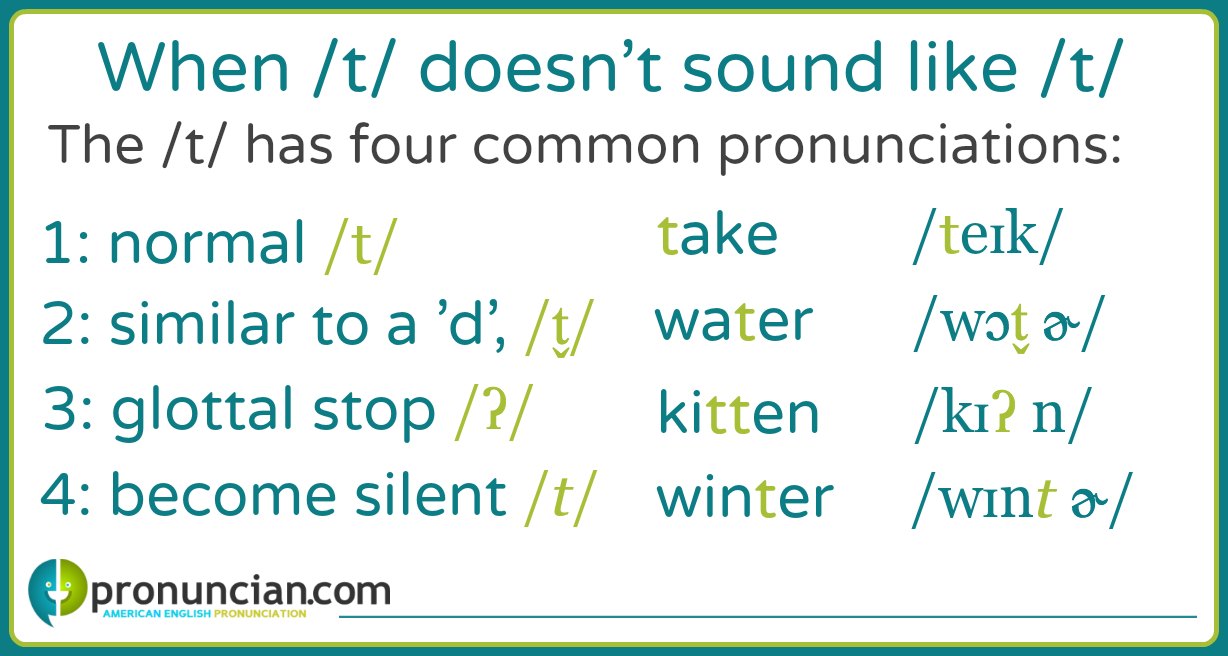The American English 't sound' /t/ Allophones
Most sounds of English do not have one exact method of production; small variations of sound (called allophones) are often so minimal that native speakers of a language often barely notice their existence. Which allophone is used depends on adjacent sounds, placement within a word, and if the sound is within a stressed syllable. While native speakers use allophones intuitively, non-native speakers benefit greatly from explicit instruction on the subject by increasing their listening comprehension as well as being perceived as more fluent speakers.
Studying allophones is complicated by the fact that most dictionaries do not show allophones in their transcriptions (the symbols they use to represent sounds). Instead, most dictionaries use a single symbol to represent all allophones of a sound. Learners who wish to fully understand allophone usage should refer to dictionaries that specialize in pronunciation, such as the Longman Pronunciation Dictionary.
The American English /t/ includes the following four common allophones:
- Remain a regularly aspirated 't sound' /t/
- Be pronounced like a quick /d/ (also called an alveolar tap) represented as /t̬/
- Become a glottal stop /ʔ/
- Be silent (omitted) /t/
1: True /t/
The /t/ is a regular, aspirated /t/ when it is the first sound of a word or a stressed syllable (or does not fit into patterns 2-4 below). This rule overrides all other /t/ allophone patterns.
In the examples below, the /t/ is pronounced normally because the sound begins a stressed syllable.
1. attach: /ə ˈtæʧ/
2. pretend: /prɪ ˈtɛnd/
3. italic: /ɪ ˈtæl ɪk/
2: Quick 'd sound' /t̬/
The alveolar stop /t̬/ sounds like a quick /d/. It occurs when a /t/ is between a vowel sound or /r/ (including all r-controlled vowels) and either another vowel sound, /r/ (including all r-controlled vowels), or a syllabic /l/.
1. daughter: /ˈdɔt̬ ɚ/
2. computer: /kəm ˈpjut̬ ɚ/
3. settle: /ˈsɛt̬ l/
This lesson, plus more exercises with examples of alternative ''t sounds' is in Pronunciation Pages.
2. certain: /ˈsɚʔ n/
3. fitness: /ˈfɪʔ nəs/
4: Omitted /t/: /t/
An italicized /t/ means that the sound can be silent—or omitted—from a word. This /t/ allophone varies the most widely among native speakers, and even within a single speaker's speech patterns. The /t/ is less likely to be omitted when the speaker is emphasizing the word for an reason. Also, among all the /t/ allophones, this usage can be considered the most informal and non-standardized.
There are two scenarios where the /t/ is often omitted.
Scenario 1) The /t/ is optionally silent when it follows /n/ and precedes a vowel sound, /r/ (including all r-controlled vowels) or a syllabic /l/.
1. center: /ˈsɛnt ɚ/
2. gentle: /ˈʤɛnt l/
3. advantage: /əd ˈvænt ɪʤ/
Scenario 2) In addition to the above instances of omitting the /t/, it is often omitted when it occurs between two consonant sounds (except the consonants specifically mentioned for /t̬/ and glottal stop). This is likely to occur when an -s ending is added to a word.
1. prints: /prɪnts/
2. acts: /ækts/
3. accepts: /ək ˈsɛpts/




